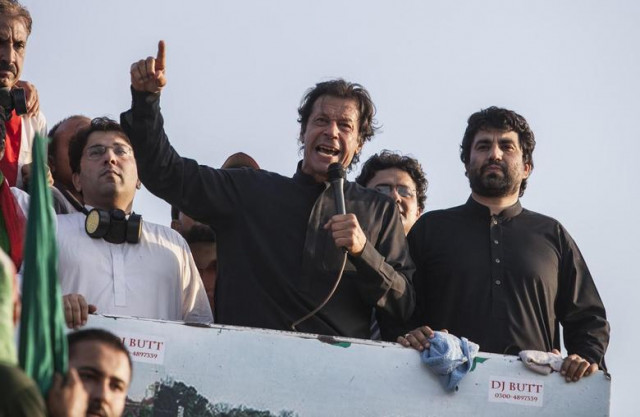
Unlike the Imran-Qadri duo dharna of 2014 that lasted 126 days with a 24/7 media coverage, Maulana had none of the juggling to offer for political entertainment other than aping PTI’s uncouth rambling to malign the government and threatening to haul the Prime Minister out of his office by the scruff of the neck.
Given that dharna politics has taken a centre stage in Pakistan’s self-styled democracy, questions are being raised on the legitimacy and success of this newly acquired protest technique to bring the governments under pressure.
Though the PTI’s 2014 dharna did not bring Nawaz Sharif’s government down, it did set the tone for his exit that was safely used once the Panama chaos presented itself as a new opportunity to stir commotion. A fresh round of dharnas, lockdowns and warnings began. The melodrama ended in August 2017 when the Supreme Court sent Nawaz Sharif home, not on the charges of stashing millions of dollars in offshore companies, but on failing to disclose the details of a resident permit (Iqama) that enabled him to work at his son’s company in the UAE against a salary.
Notwithstanding the economic implications of the dharnas, the growing involvement of the courts in expeditiously deciding political cases have given the impression of a senior judiciary beholden to the powers that be, by giving favourable verdicts.
The courts had initially refused to take up the Panama case, advising the political parties to resolve the matter in Parliament. Thanks to the spin doctors, the second dharna by the PTI in January 2016, followed by the threat to lock down Islamabad, provided the narrow opportunity for the senior courts to jump in the fray and give the proverbial last push.
What followed was an imminent emergence of the PTI in power without achieving a majority in Parliament though. In the meantime, the National Accountability Bureau (NAB), invested with the task to probe corruption cases against the politicians, went in with full swing. From bureaucracy to heads of state, the process of weeding out the corrupt elements from politics brought to a standstill the only job for which governments are formed: governance. Because of a dysfunctional bureaucracy (fearing NAB’s spectre) the country is mired in the worst economic crisis where exports have stagnated, the debt to GDP ratio has risen geometrically, imports have become more expensive — making costlier the CPEC-related projects — and large-scale manufacturing is registering a negative growth.
With a tax to GDP ratio already at the lowest in the region, Pakistan has no option but to run the government through borrowed funds either from the IMF or through domestic banks using the instrument of T-Bills that further repels the private sector in what is called the crowding-out effect.
In the first fiscal year of the PTI’s rule, Pakistan’s debt and liabilities surged from Rs29.88 trillion to Rs40 trillion ($255 billion). This means that the PTI added Rs11 trillion (more than $70 billion) to the public debt in one year.
The PML-N government had to bear with not only the PTI dharna but also with the additional nuisance of countrywide dharnas by the wheelchair-bound cleric, Khadim Hussain Rizvi, that culminated in the infamous Faizabad dharna, which, like in other similar cases, ended through military intervention.
The question is: what has Pakistan gained from this dharna politics which is staged to get rid of unscrupulous governments.
According to the reports published in various newspapers in Pakistan, a loss of approximately Rs3.7 trillion was incurred from PTI-led protests, comprising: the Islamabad jalsa, Sialkot jalsa, Bahawalpur jalsa, PTI-PAT Azadi March and 126-day-long dharna, followed by a transporters’ strike in 2017 and the violent Tehreek-e-Labbaik protest in 2017-18. On September 26, 2014, the then prime minister, Nawaz Sharif, had also stated that since August 14, 2014, the total economic loss had reached $6 billion.
In addition to the material loss, protests and sit-ins bring negative tilt to the image of Pakistan that strains investors’ sentiments.
In the midst of this self-created confusion, there is a lesson to learn from none other than Bangladesh, which economic experts predict will become the next Asian Tiger, despite conducting compromised elections, having a large population fighting poverty and witnessing occasional incidents of terrorism.
Bangladesh’s economy has been growing at a rate of 7.8% annually. The IMF calculates Bangladesh’s economy to grow from the current $180 billion to $322 billion by 2021.
Much of this growth comes from exports which grew from zero in 1971 to $35.8 billion in 2018 (Pakistan’s was $24.8 billion).
What has made Bangladesh a resounding economic success without either being a geostrategic asset, or possessing nuclear power, or having a big strong army or being at the crosshair of a fifth-generation secret subversion plan?
The secret to Bangladesh’s success lies in its unwavering commitment to national interest. In spite of bullies in the form of powerful neighbours — India keeps pulling punches at Bangladesh on water issues — it refused to deter from its goals of human development and economic growth. The consistent economic policies have contributed in making foreign investors and businessmen take full advantage of the low-cost and dedicated Bangladeshi labour.
Whereas in Pakistan, a common man is unable to make ends meet. Rising inflation and unemployment have had a direct bearing on the behaviour of the people, making them increasingly intolerant and conspiratorial.
The paranoia about India’s intent to devour Pakistan has affected the prospect of development and political stability within.
If arm-twisting can be effectively used to oust governments through dharnas, it could also be used for the exercise of ending the predatory culture, where all are equal, but some are more equal than others.
In short, a new social contract is in the calling to put Pakistan on the road to progress.
Published in The Express Tribune, December 12th, 2019.
Like Opinion & Editorial on Facebook, follow @ETOpEd on Twitter to receive all updates on all our daily pieces.








1726054615-0/OpenAI-(2)1726054615-0-270x192.webp)





COMMENTS
Comments are moderated and generally will be posted if they are on-topic and not abusive.
For more information, please see our Comments FAQ